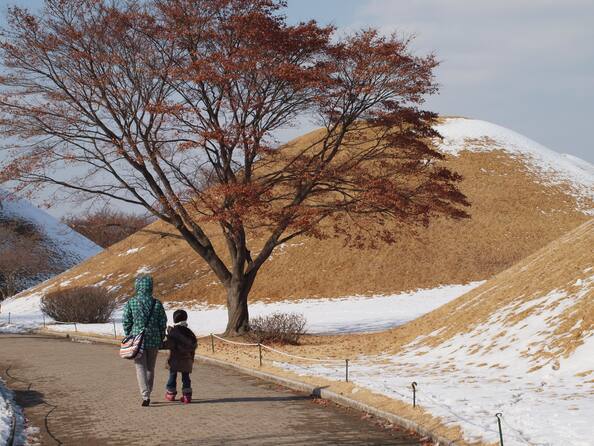庆州历史区
Gyeongju Historic Areas
The Gyeongju Historic Areas contain a remarkable concentration of outstanding examples of Korean Buddhist art, in the form of sculptures, reliefs, pagodas, and the remains of temples and palaces from the flowering, in particular between the 7th and 10th centuries, of this form of unique artistic expression.
La description est disponible sous licence CC-BY-SA IGO 3.0
Zones historiques de Gyeongju
Les zones historiques de Gyeongju contiennent une remarquable concentration d'exemples exceptionnels de l'art bouddhiste coréen sous forme de sculptures, de reliefs, de pagodes et de vestiges de temples et de palais datant de la période qui a vu s'épanouir cette forme d'expression artistique unique, en particulier du VIIe au Xe siècle.
La description est disponible sous licence CC-BY-SA IGO 3.0
مناطق كيونغ جو التاريخية
تحتوي مناطق كيونغ جو التاريخية على مجموعة كثيفة من النماذج الرائعة للفن البوذي الكوري تتمثل في منحوتات ونقوش ومعابد باغود برجية وآثار معابد وقصور عائدة الى مرحلة ازدهار هذا الشكل التعبيري الفريد الممتد خاصة من القرن السابع الى القرن العاشر.
source: UNESCO/CPE
La description est disponible sous licence CC-BY-SA IGO 3.0
庆州历史区
庆州历史区内有大量韩国佛教艺术的精品,包括雕刻、浮雕、佛塔以及许多从公元7世纪至10世纪佛教艺术鼎盛时期流传下来的庙宇和宫殿遗址。
source: UNESCO/CPE
La description est disponible sous licence CC-BY-SA IGO 3.0
Исторические территории Кёнджу
В районе Кёнджу сосредоточено множество замечательных памятников корейского буддийского искусства, которые представлены скульптурами, барельефами, пагодами, а также руинами храмов и дворцов, в основном относящихся к периоду VII-X вв.
source: UNESCO/CPE
La description est disponible sous licence CC-BY-SA IGO 3.0
Zonas históricas de Gyeongju
En las zonas históricas de Gyeongju hay una importante concentración de obras y monumentos extraordinarios del arte budista coreano –esculturas, relieves, pagodas y vestigios de templos y palacios– que datan en particular de los siglos VII a X, época del florecimiento de esta expresión estética única en su género.
source: UNESCO/CPE
La description est disponible sous licence CC-BY-SA IGO 3.0
慶州歴史地域
朝鮮半島東海岸、慶尚北道にあり、新羅王国の首都・金城として3~10世紀の間、朝鮮半島の中心地として栄えた。慶州市内外に見られる200余りの緑の丘は1世紀以来の新羅王たちの古墳で、7世紀に半島を統一後、中国の大都市を範として首都を拡大・整備した。仏像、レリーフ、仏塔、寺院跡、宮殿跡など、韓国仏教美術の傑作の数々が驚くべき集中度で保存され、7~10世紀にかけてこの地で花開いたユニークな芸術表現様式を見せてくれる。source: NFUAJ
Historische gebieden van Gyeongju
De historische gebieden van Gyeongju bevatten een opmerkelijke concentratie van Koreaanse boeddhistische kunst. Er zijn beelden, reliëfs, pagodes en overblijfselen van tempels en paleizen uit de hoogtijdagen – met name tussen de 7e en 10e eeuw – van deze vorm van artistieke expressie. Het Koreaanse schiereiland werd bijna 1.000 jaar door de Silla dynastie geregeerd, van 57 voor Christus tot 935 na Christus. De omgeving en de monumenten in en rond Gyeongju getuigen van de culturele verworvenheden van het gebied. De monumenten zijn van uitzonderlijke betekenis voor de ontwikkeling van de boeddhistische en seculiere architectuur in Korea.
Source : unesco.nl
